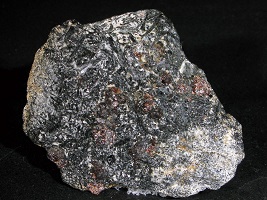
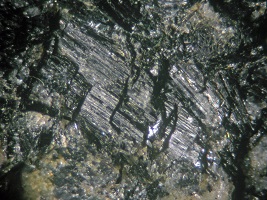
Locality: Franconia, NH
Specimen Size: 5.7 cm specimen with black-green blades of magnesiogedrite and almandine (analyzed) garnet. Zoom view 10 mm.
Field Collected: Joey Vaughan - 1/31/17
Catalog No.: 2027
Notes: An EDS analysis (BC170) indicates these black-green blades are magnesiogedrite. Magnesiogedrite (previously a distinct species) is now classified as a variety of gedrite.
Magnesiogedrite chemistry (webmineral) is: Mg3Fe+22Al2(Si6Al2O22)(OH)2
The RUFF data base provides a "measured chemistry" for gedrite of:
(vacant0.61Na0.39)(Mg4.55Fe2+1.40Al0.91Ti0.07Ca0.07)(Si6.56Al1.44)O22(OH)2
The analysis suggests a chemistry (normalized for 2 Al): Mg2.68Fe2.12Al2Si3.22O28
Some comments on these three chemistries:
Webmineral Fe + Mg = 5, RUFF Mg + Fe = 5.95, Franconia Fe + Mg = 4.8. All somewhat close.
Webmineral Al = 4, RUFF Al = 2.35, Franconia Al = 2. RUFF & webmineral very different
Webmineral Si = 6, RUFF Si= 6.56, Franconia Si = 3.22. Franconia very low
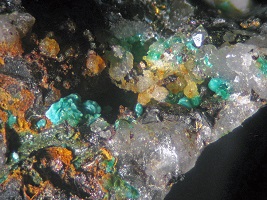
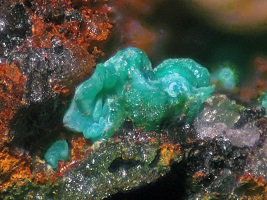
Locality: Palermo Mine, N. Groton, NH
Specimen Size: 5 mm field of view
Field Collected: Gift from Gordon Jackson. Field collected Clayton Ford.
Catalog No.: u2012
Notes: A carbon tape EDS analysis (BC164) showed no phosphorous, just copper, so this is malachite, not pseudomalachite.
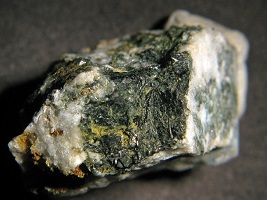

Locality: Palermo Mine, N. Groton, NH
Specimen Size: 2.2 cm specimen, 3 mm zoom view shows some crystal faces. Dark forrest-green embedded blades of kulanite.
Field Collected: Walter Lane - MMNE give-away
Catalog No.: u2025
Notes: An EDS analysis (BC175 - 3/2/17) indicated a chemistry of: (normalized for 2 Al):
Ba0.33(Fe1.1,Mn0.6)Al2(PO4)3(OH)3 + 20 extra O. Light on the barium.
Kulanite chemistry is: BaFe2Al2(PO4)3(OH)3 Kulanite is the only species chemistry that comes close to the iron dominant phosphate indicated by the BC175 analysis. The color and luster are consistent with kulanite.
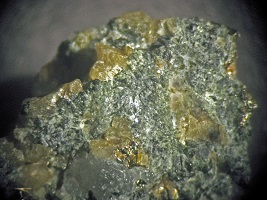
Locality: Palermo Mine, N. Groton, NH
Specimen Size: 2.2 cm specimen, 1.5 cm field of view. Pale gray-green granular arrojadite group mineral in tan-yellow siderite.
Field Collected: Walter Lane - MMNE give-away
Catalog No.: u2026
Notes: A non-stacked photo... not a lot to see here. An EDS analysis strongly suggests an arrojadite group mineral. This group has 14 members.
Arrojadite-(KFeNa) seems to be about the best fit.
The color and luster are consistent with typical arrojadite group minerals at Palermo. Some collectors might simply dismiss this as poor apatite, which it clearly is not.
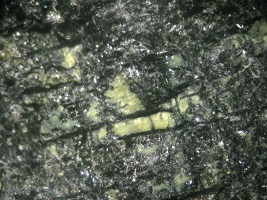
Locality: Fletcher Mine, N. Groton, NH
Specimen Size: 7 mm field of view. Pale green tavorite in rockbridgeite.
Field Collected: Clayton Ford acquired by Gordon Jackson 9/22/03, gifted to Tom Mortimer 2016.
Catalog No.: u2032
Notes: A non-stacked photo. An EDS analysis was consistent with a tavorite identification. Tavorite chemistry is LiFe(PO4)(OH). EDS cannot detect lithium.
Color, fine-grain appearance, and rockbridgeite association are also appropriate for Groton, NH occurrences of tavorite.
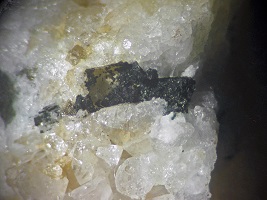
Locality: Palermo Mine, N. Groton, NH
Specimen Size: 7 mm field of view. Blue-black disolving sulfide = sphalerite.
Field Collected: Clayton Ford acquired by Gordon Jackson 9/22/03, gifted to Tom Mortimer 2016.
Catalog No.: u2015
Notes: An EDS analysis (BC181) showed only zinc and sulfur, so sphalerite. From the bluish tarnish, I thought might be bornite. Some of the blocky clear crystals in the foreground are not quartz. Need further study.
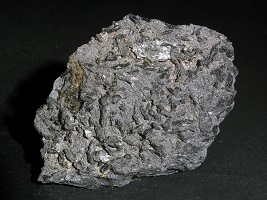
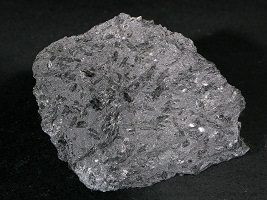
Locality: 2 Mile Rd. Hanover, NH
Specimen Size: 6.5 cm specimen, magnesiohornblende crystals in diabase matrix, front and back sides
Field Collected: Tom Mortimer - 9/25/11
Catalog No.: 2029
Notes: An EDS analysis (BC182 - 3/2/17) indicated magnesiohornblende was the best species fit for this amphibole.
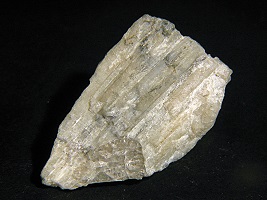
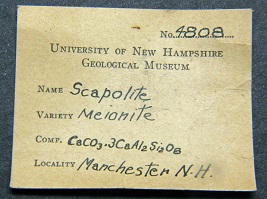
Locality: Road cut near the Manchester Armory site, Manchester, NH
Specimen Size: 5 cm specimen. Cream colored scapolite prisms in quartz.
Field Collected: Unknown
Catalog No.: 2037
Notes: This is a Phillip Morrill listed locality. A skarn was uncovered during work on a road cut near the Manchester Armory, 1939. The find (made by a Manchester high school student) was reported in the 1939 issue of Rocks and Minerals , pg. 349. This specimen was salvaged by Dana Morong from the UNH mineral collection "de-acquisition." This is only the third specimen I [tm] have seen from this site. The other two are in the Woodman Institute, Dover, NH, collection. As of 2017, these are the best examples of NH scapolite.
The number on specimen matches the number on label. The scapolite fluoresces rose color in SW UV and pale-mustard-yellow in LW UV.
A May 2017 EDS analysis clearly showed the meionite member of the meionite-marialite scapolite series.
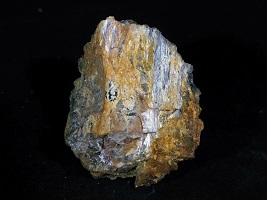
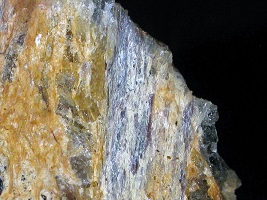
Locality: Devil's Den Locality, Auburn, NH
Specimen Size: 3.5 cm specimen. Gray-white kyanite blade in iron-stained quartz.
Field Collected: Tom Mortimer - 2017
Catalog No.: 2033
Notes: This is a Phillip Morrill listed locality.
Research on this locality by Peter Cristofono found; "the Devil's Den reference is pre-Hitchcock. I just found Devil's Den tremolite listed in Robinson (1825), A Catalogue of American Minerals and their Localities: 'Chester -- Tremolite, bladed and abundant, near the Devil's den.' (Auburn was part of Chester until 1845) -- Robinson also lists sulphur under Chester: 'Native sulphur, is found in small quantities, in tremolite.' Looking further, I found Robinson's source to be: John Farmer and Jacob B. Moore (1823), A Gazetteer of the State of New-Hampshire, p. 22. 'Tremolite---Chester, near the Devil's den, bladed and abundant.' In Jeremy Belknap's The History of New-Hampshire, Vol. 3 (1792), there is a description by Peter French of Devils' Den, p. 188. in which he describes stalactites, etc. and 'sulphur' and this is probably the source of Robinson's sulphur report. But French's description seems very exaggerated. I could not find a reference yet of any mining activity there."
Mindat has an old postcard photo of this locality: mindat.org Devil's Den photo
However a May 2017 attempted EDS confirmation of tremolite showed just an aluminum silicate! No Mg or Ca, so not tremolite. EDS cannot diofferentiate between kyanite, andalusite and sillimanite, but based on other NH occurances of this simple aluminun silicate in quartz, my first choice for this specimen is kyanite. So is tremolite really present at Devil's Den, or has this bladed mineral been long miss-identified as tremolite? I would like to hear from any collector who has or spots an Auburn, Devil's Den tremolite.
Some areas of this specimen have a brown mica, likely the magnesium mica, phlogopite.
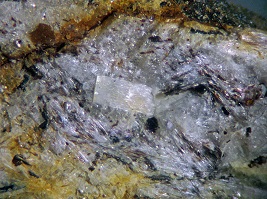
Locality: Devil's Den Locality, Auburn, NH
Specimen Size: Satin 1.8 mm kyanite blade in nest of acicular kyanite.
Field Collected: Tom Mortimer - 2017
Catalog No.: 2034
Notes: See discussion for # 2033. Brown mica flakes are likely phlogopite.